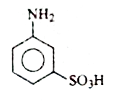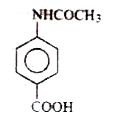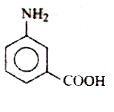A white crystalline solid X give following chemical test :
(i) it liberates CO2 with NaHCO3
(ii) it forms a coloured dye on diazotisation and coupling with β - naphthol
(iii) with Br2 water it forms white precipitate of 2,4,6 - tribromo aniline .
'X' can be identified as :




The correct Answer is:B
To identify the white crystalline solid X, we will analyze the given chemical tests step by step.
Step 1: Analyzing the first test
The first test states that X liberates CO₂ with NaHCO₃. This reaction indicates that X must contain a carboxylic acid group (−COOH) or a sulfonic acid group (−SO₃H). Both of these functional groups can react with sodium bicarbonate to release carbon dioxide.
Hint: Look for compounds that contain either a carboxylic acid or a sulfonic acid group.
Step 2: Analyzing the second test
The second test indicates that X forms a colored dye upon diazotization and coupling with β−naphthol. This suggests that X must contain an amino group (−NH₂), as diazotization is a characteristic reaction of aniline derivatives. The reaction involves converting the amino group into a diazonium salt, which can then couple with β−naphthol to form a colored compound.
Hint: Identify compounds that have an amino group (−NH₂) attached to a benzene ring.
Step 3: Analyzing the third test
The third test states that X reacts with Br₂ water to form a white precipitate of 2,4,6−tribromoanil∈e. This reaction is characteristic of aniline derivatives, where the amino group is highly reactive towards electrophilic substitution. The presence of the amino group allows for bromination at the ortho and para positions, leading to the formation of 2,4,6−tribromoanil∈e.
Hint: Confirm that the compound can undergo bromination at the ortho and para positions due to the presence of the amino group.
Step 4: Evaluating the options
Now, we can evaluate the options based on the information gathered:
- Option A: Contains a −COOH group but lacks an −NH₂ group.
- Option B: Contains both −COOH and −NH₂ groups, making it a suitable candidate.
- Option C: Contains an −NHCO group instead of −NH₂, which is not suitable.
- Option D: Similar to A, it lacks the necessary −NH₂ group.
Based on the evaluations, Option B is the correct identification of the compound X.
Final Answer
X can be identified as Option B.
The first test states that X liberates CO₂ with NaHCO₃. This reaction indicates that X must contain a carboxylic acid group (−COOH) or a sulfonic acid group (−SO₃H). Both of these functional groups can react with sodium bicarbonate to release carbon dioxide.
The second test indicates that X forms a colored dye upon diazotization and coupling with β−naphthol. This suggests that X must contain an amino group (−NH₂), as diazotization is a characteristic reaction of aniline derivatives. The reaction involves converting the amino group into a diazonium salt, which can then couple with β−naphthol to form a colored compound.
The third test states that X reacts with Br₂ water to form a white precipitate of 2,4,6−tribromoanil∈e. This reaction is characteristic of aniline derivatives, where the amino group is highly reactive towards electrophilic substitution. The presence of the amino group allows for bromination at the ortho and para positions, leading to the formation of 2,4,6−tribromoanil∈e.
Now, we can evaluate the options based on the information gathered:
- Option B: Contains both −COOH and −NH₂ groups, making it a suitable candidate.
- Option C: Contains an −NHCO group instead of −NH₂, which is not suitable.
- Option D: Similar to A, it lacks the necessary −NH₂ group.
X can be identified as Option B.
Similar Questions
A whiite crystalline salt imparts a violet colour to a Bunsen flame, and with hot concentrated H2SO4, forms a pungent gas. On treatment with an AgNO3 solution, this gas forms a white precipitate readily soluble in NH3. The whiite crystalline salt may be:
View SolutionFind the derivative of the following function with respect to 'X' (i) x4 (ii) x−3 (iii) 3x2
View SolutionA white crystalline compound (X) swells open heating and gives violet-coloured flame. Its aqueous solution gives the following reactions :
(a) A white precipitate is formed, with BaCl2 in presence of HCl.
(b) When treated with excess of NH4OH, it gives white gelatinous precipitate. the white precipitate dissolves in NaOH and reappears on boiling with concentrated solution of NH4Cl.
( c) It gives yellow precipitate with cobaltinitrite solution. Identify (X) and explain the reaction at steps a,b and c.
View SolutionWhen H2S gas a passed through an ammonical salt solution X, a slightly white precipitate is formed. The X can be:
View SolutionAn unknown inorganic compound (X) loses it water of crystallisation on heating and its aqueous solution gives the following reaction.
(i) It gives a white turbidity with dilute hydrochloric acid solution.
(ii) It decolourises a solution of iodine in potassium iodide.
(iii) It gives a white precipitate with silver nitrate solution which turns black on standing. Identify the compound (X) and give chemical equations for the reaction at step (i) to (iii).
View SolutionA compound (A) is greenish crystalline salt, which gave the following reactions.
(i)Addition of BaCl2 solution to the solution of (A) results in the formation of white precipitate (B) which is insoluble in dilute HCl.
(ii)On heating (A), water vapours and two oxides of sulphur (C) and (D) are liberated leaving a red brown residue (E).
(iii)(E) dissolves in warm concentrated HCl to give a yellow solution (F).
(iv)Solution (F) on treatment with thiocyanate ions gives blood red coloured compound (G).
Identify the compounds from (A) to (G).
View SolutionAn organic compound A’ with molecular formula C7H7NO reacts with Br2/aqKOH to give compound B’, which upon reaction with NaNO2&HCl at O∘C gives C’. Compound C’ on heating with CH3CH2OH gives a hydrocarbon D’. Compound B’ on further reaction with Br2 water gives white precipitate of compound E’. Identify the compound A, B, C, D&E, also justify your answer by giving relevant chemical equations.
View SolutionOne cationic complex has to isomers A and B Each has one Co3+ five NH3 one CIΘ and one SO2−4 stoichiometically A give white precipitate with BaCI2 white B gives white precipitate with AgNO3
A can be .
View SolutionOne cationic complex has to isomers A and B Each has one Co3+ five NH3 one CIΘ and one SO2−4 stoichiometically A give white precipitate with BaCI2 white B gives white precipitate with AgNO3
(B) can be .
View SolutionThe metallic salt (XY) is soluble in water.
(a) When the aqueous soluble of (XY) is treated with NaOH solution, a white precipitate (A) is formed. In excess of NaOH solution, a white precipitate (A) is formed. In excess of NaOH solution, white precipitate (A) dissolves to form a compound (B). When this solution is boiled with soild NH4Cl, a precipitate of compound (C) is formed.
(b) An aqueous solution on treatment with BaCl2 solution gives a white precipitate (D) white is insoluble in conc HCl.
( c) The metallic salt (XY) forms a double salt (E) with potassium sulphate.
Identify (XY),(A),(B),(C),(D) and (E).
View Solution